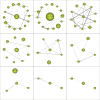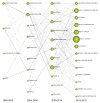Evolutionary Overview of Consumer Health Informatics: Bibliometric Study on the Web of Science from 1999 to 2019
- PMID: 34499042
- PMCID: PMC8461533
- DOI: 10.2196/21974
Evolutionary Overview of Consumer Health Informatics: Bibliometric Study on the Web of Science from 1999 to 2019
Abstract
Background: Consumer health informatics (CHI) originated in the 1990s. With the rapid development of computer and information technology for health decision making, an increasing number of consumers have obtained health-related information through the internet, and CHI has also attracted the attention of an increasing number of scholars.
Objective: The aim of this study was to analyze the research themes and evolution characteristics of different study periods and to discuss the dynamic evolution path and research theme rules in a time-series framework from the perspective of a strategy map and a data flow in CHI.
Methods: The Web of Science core collection database of the Institute for Scientific Information was used as the data source to retrieve relevant articles in the field of CHI. SciMAT was used to preprocess the literature data and construct the overlapping map, evolution map, strategic diagram, and cluster network characterized by keywords. Besides, a bibliometric analysis of the general characteristics, the evolutionary characteristics of the theme, and the evolutionary path of the theme was conducted.
Results: A total of 986 articles were obtained after the retrieval, and 931 articles met the document-type requirement. In the past 21 years, the number of articles increased every year, with a remarkable growth after 2015. The research content in 4 different study periods formed the following 38 themes: patient education, medicine, needs, and bibliographic database in the 1999-2003 study period; world wide web, patient education, eHealth, patients, medication, terminology, behavior, technology, and disease in the 2004-2008 study period; websites, information seeking, physicians, attitudes, technology, risk, food labeling, patient, strategies, patient education, and eHealth in the 2009-2014 study period; and electronic medical records, health information seeking, attitudes, health communication, breast cancer, health literacy, technology, natural language processing, user-centered design, pharmacy, academic libraries, costs, internet utilization, and online health information in the 2015-2019 study period. Besides, these themes formed 10 evolution paths in 3 research directions: patient education and intervention, consumer demand attitude and behavior, and internet information technology application.
Conclusions: Averaging 93 publications every year since 2015, CHI research is in a rapid growth period. The research themes mainly focus on patient education, health information needs, health information search behavior, health behavior intervention, health literacy, health information technology, eHealth, and other aspects. Patient education and intervention research, consumer demand, attitude, and behavior research comprise the main theme evolution path, whose evolution process has been relatively stable. This evolution path will continue to become the research hotspot in this field. Research on the internet and information technology application is a secondary theme evolution path with development potential.
Keywords: SciMAT; co-word analysis; consumer health informatics; consumer health information; informatics; thematic evaluation.
©Wei Ouyang, Wenzhao Xie, Zirui Xin, Haiyan He, Tingxiao Wen, Xiaoqing Peng, Pingping Dai, Yifeng Yuan, Fei Liu, Yang Chen, Aijing Luo. Originally published in the Journal of Medical Internet Research (https://www.jmir.org), 09.09.2021.
Conflict of interest statement
Conflicts of Interest: None declared.
Figures










Similar articles
-
Mapping publication trends and identifying hot spots of research on Internet health information seeking behavior: a quantitative and co-word biclustering analysis.J Med Internet Res. 2015 Mar 25;17(3):e81. doi: 10.2196/jmir.3326. J Med Internet Res. 2015. PMID: 25830358 Free PMC article.
-
What is eHealth (4): a scoping exercise to map the field.J Med Internet Res. 2005 Mar 31;7(1):e9. doi: 10.2196/jmir.7.1.e9. J Med Internet Res. 2005. PMID: 15829481 Free PMC article. Review.
-
Visualizing the intellectual structure and evolution of electronic health and telemedicine research.Int J Med Inform. 2019 Oct;130:103947. doi: 10.1016/j.ijmedinf.2019.08.007. Epub 2019 Aug 13. Int J Med Inform. 2019. PMID: 31450080
-
A Comparison of the Development of Medical Informatics in China and That in Western Countries from 2008 to 2018: A Bibliometric Analysis of Official Journal Publications.J Healthc Eng. 2020 Oct 12;2020:8822311. doi: 10.1155/2020/8822311. eCollection 2020. J Healthc Eng. 2020. PMID: 33101616 Free PMC article.
-
Physical Activity, Sedentary Behavior, and Diet-Related eHealth and mHealth Research: Bibliometric Analysis.J Med Internet Res. 2018 Apr 18;20(4):e122. doi: 10.2196/jmir.8954. J Med Internet Res. 2018. PMID: 29669703 Free PMC article. Review.
Cited by
-
Digital Health Literacy: Bibliometric Analysis.J Med Internet Res. 2022 Jul 6;24(7):e35816. doi: 10.2196/35816. J Med Internet Res. 2022. PMID: 35793141 Free PMC article.
-
Consumer Health Informatics to Advance Precision Prevention.Yearb Med Inform. 2024 Aug;33(1):149-157. doi: 10.1055/s-0044-1800735. Epub 2025 Apr 8. Yearb Med Inform. 2024. PMID: 40199300 Free PMC article. Review.
-
Multidisciplinary Contributions and Research Trends in eHealth Scholarship (2000-2024): Bibliometric Analysis.J Med Internet Res. 2025 Jun 16;27:e60071. doi: 10.2196/60071. J Med Internet Res. 2025. PMID: 40522718 Free PMC article.
-
Challenges and Opportunities for Professional Medical Publications Writers to Contribute to Plain Language Summaries (PLS) in an AI/ML Environment - A Consumer Health Informatics Systematic Review.AMIA Annu Symp Proc. 2024 Jan 11;2023:709-717. eCollection 2023. AMIA Annu Symp Proc. 2024. PMID: 38222388 Free PMC article.
-
A bibliometric analysis of research progress on pharmacovigilance and cancer from 2002 to 2021.Front Oncol. 2023 Jan 25;13:1078254. doi: 10.3389/fonc.2023.1078254. eCollection 2023. Front Oncol. 2023. PMID: 36761953 Free PMC article. Review.
References
-
- Ferguson T. Consumer health informatics. Healthc Forum J. 1995;38(1):28–33. - PubMed
-
- Eysenbach G. Consumer health informatics. BMJ. 2000 Jun 24;320(7251):1713–1716. doi: 10.1136/bmj.320.7251.1713. http://europepmc.org/abstract/MED/10864552 - DOI - PMC - PubMed
-
- American Medical Informatics Association Consumer Health Informatics. [2020-06-08]. https://www.amia.org/applications-informatics/consumer-health-informatics .
-
- Kokol P, Saranto K, Vosner HB. eHealth and health informatics competences: A systemic analysis of literature production based on bibliometrics. Kybernetes. 2018 Mar 05;47(5):1018–1030. doi: 10.1108/k-09-2017-0338. - DOI
Publication types
MeSH terms
LinkOut - more resources
Full Text Sources
Medical
Miscellaneous

